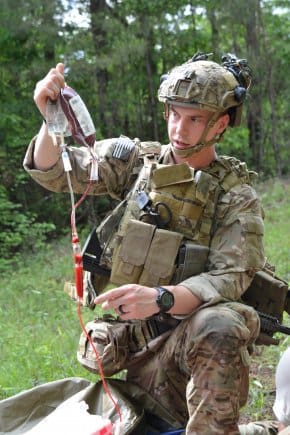Yesterday, the Army Materiel Command recognized the 75th Ranger Regiment’s ROLO or Ranger O Low Titer Whole Blood Program as the individual military winner of the US Army’s Greatest Innovation Award at the Association of the United States Army Global Warfare Symposium in Huntsville, Alabama. The ROLO Program, developed in collaboration with international civilian and military providers of the Trauma Hemostasis and Oxygenation Research, or THOR, Network, was created to bring emergency blood transfusions from the hospital to the field.
Under the program, unit members with O-type blood are identified, and then tested for IgM titers to determine potential donors to be used as the POI, or Point of Injury. Due largely to the efforts of Lt. Col. Andre Cap, Chief of Blood Research at the Army Institute of Surgical Research, and Lt. Col. Jason Corley, Deputy Director of the Army Blood Program, the ROLO Program has been fully implemented at the unit level in just 18 months.
For more information on the US Army’s Greatest Innovation Award Program, visit www.amc.army.mil/amc/agiap.
Original Story: www.army.mil/article/184219/Ranger_Whole_Blood_Program_wins_an_Army_s_Greatest_Innovation_Award
Tags: US Army



Not as organized nor with accreditation, but 18Ds have been doing this for a very, very long time. I knew all my guys blood types and had the bags for emergency transfusions. Just got real lucky that I never had to use it. Used my share of Hespan though.
Of course I’m still waiting on the IV hemoglobin that we always heard about but never saw come to fruition.
That’s impressive, indicative of how guys have to adapt and think out of the box to save lives
Great job. The USAISR gets shit done. Most significant innovations in civilian trauma care in the last 50 years can be traced back to have at least some linkage to this valuable asset of a facility.